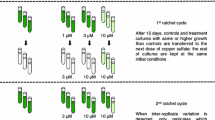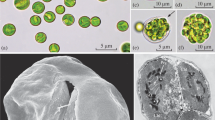Abstract
A study was made of the tolerance to Cu of 11 strains of Cyanophyceae and 7 strains of eukaryotes. These had all been tested within 6 months after isolation for their photosynthetic activity when exposed to Cu (Takamuraet al., 1989) and had repeatedly been subcultured in the medium without Cu for 2 years. Photosynthetic measurements were made in two ways: precultured in medium without Cu or precultured (for one subculture) in medium containing Cu (645 μg 1−1). The results were compared with those obtained within 6 months of isolation. The tolerance of the eukaryotes did not change significantly in any case, but most strains of Cyanophyceae lost their tolerance to Cu within a few subcultures in medium without Cu; however tolerance recovered following one subculture in medium containing an intermediate level of Cu. This rapid adaptation cannot be explained by a constitutive mutation.
Similar content being viewed by others
References
Hama T, Miyazaki T, Ogawa Y, Iwakuma T, Takahashi M, Otsuki A, Ichimura S (1983) Measurement of photosynthetic production of marine phytoplankton population by using a stable13C isotope. Mar. Biol. 73: 31–36.
Harding JPC, Whitton BA (1976) Resistance ofStigeoclonium tenue in the field and the laboratory. Br. phycol. J. 11: 417–426.
Kuwabara JS, Leland HV (1986) Adaptation ofSelenastrum capricornatum (Chlorophyceae) to copper. Environ. Tox. Chem. 5: 197–203.
Leland HV, Carter LL (1984) Effects of copper on species composition of periphyton in a Sierra Nevada, California, stream. Freshwat. Biol. 14: 281–296.
Olafson RW (1986) Physiological and chemical characterization of cyanobacterial metallothioneins. Envir. Health Perspectives 65: 71–75.
Olafson RW, Loya S, Sim RG (1980) Physiological parameters of prokaryotic metallothionein induction. Biochem. Biophys. Res. Commun. 95: 1495–1503.
Shehata FHA, Whitton BA (1982) Zinc tolerance in strains of the blue-green algaAnacystis nidulans. Br. Phycol. J. 17: 5–12.
Stokes PM (1975) Adaptation of green algae to high levels of copper and nickel in aquatic environments. In: Hutchinson TC (ed), International Conference on Heavy Metals in the Environment, Toronto, Canada, 137–154.
Stokes PM (1983) Responses of freshwater algae to metals. In: Round FE, Chapman DJ (eds), Progress in Phycological Research, 2. Elsevier, N.Y., 87–112.
Takamura N, Hatakeyama S, Sugaya Y (1990) Seasonal changes in species composition and production of periphyton in an urban river running through an abandoned copper mining region. Jpn. J. Limnol. 51: 225et seq.
Takamura N, Kasai F, Watanabe MM (1989) Effects of Cu, Cd and Zn on photosynthesis of freshwater benthic algae. J. appl. Phycol. 1: 39–52.
Yasuno M, Fukushima S (1987) Attached algal flora in the rivers receiving effluent from copper mines in Japan. Acta Biologica Hungarica 38: 141–153.
Watanabe MM, Kasai F, Sudo R (1988) NIES Collection list of strains. 2nd edn. Microalgae and protozoa. NIES, Japan, 148 pp.
Author information
Authors and Affiliations
Rights and permissions
About this article
Cite this article
Takamura, N., Kasai, F. & Watanabe, M.M. Unique response of Cyanophyceae to copper. J Appl Phycol 2, 293–296 (1990). https://doi.org/10.1007/BF02180917
Received:
Revised:
Accepted:
Issue Date:
DOI: https://doi.org/10.1007/BF02180917




